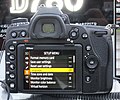 | |
| Overview | |
|---|---|
| Maker | Nikon |
| Type | Digital single-lens reflex |
| Released | 6 January 2020 |
| Lens | |
| Lens mount | Nikon F-mount |
| Sensor/medium | |
| Sensor type | BSI CMOS |
| Sensor size | 35.9 x 23.9 mm (Nikon FX format) |
| Sensor maker | Sony [1] |
| Maximum resolution | 6,048 x 4,024 pixels (24.3 megapixels) |
| Film speed | 100–51,200, extended mode 50 to 204,800 |
| Recording medium | Two slots for SD, SDHC or SDXC memory cards (UHS-II compliant) |
| Focusing | |
| Focus modes | Instant single-servo (AF-S); continuous-servo (AF-C); auto AF-S/AF-C selection (AF-A); manual (M) |
| Focus areas | 51 focus points |
| Exposure/metering | |
| Metering modes | Matrix metering, center-weighted metering, spot metering, highlight-weighted |
| Flash | |
| Flash exposure compensation | -3 to +1 EV in increments of 1/3 or 1/2 EV |
| Flash synchronization | 1/200s max |
| Shutter | |
| Shutter | Electronically controlled vertical-travel focal-plane shutter |
| Shutter speeds | 1/8,000 s to 30 s (extendable to 900 s in manual mode) and bulb |
| Continuous shooting | 7 frames per second Live view: 8 frames per second (14-bit), 12 fps (12-bit) |
| Viewfinder | |
| Viewfinder magnification | 0.7 |
| Frame coverage | 100% |
| Image processing | |
| Image processor | EXPEED 6 |
| White balance | Yes |
| General | |
| Video recording | 4K up to 30 fps 1080p up to 120 fps |
| LCD screen | 3.2 inches with 2,359,000 dots; tilting, touch enabled |
| Battery | EN-EL15b |
| AV port | HDMI Type C |
| Data port | USB-C |
| Dimensions | 143.5 x 115.5 x 76 mm (5.7 x 4.6 x 3 inches) [2] |
| Weight | 755 g (27 oz) camera body only (840 g with battery and SD card) |
| Latest firmware | 1.20 / 5 August 2025 [3] |
| Made in | |
| Chronology | |
| Predecessor | Nikon D750 |
The Nikon D780 is a full-frame DSLR camera announced by Nikon on January 6, 2020. [4] [5] [6] [7] It was released for purchase on January 23, 2020. [8] It is the successor to the Nikon D750 and has incorporated a lot of technologies from the mirrorless Z6 camera. [9]







